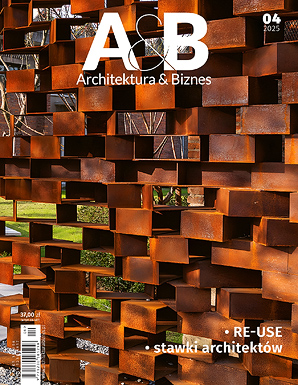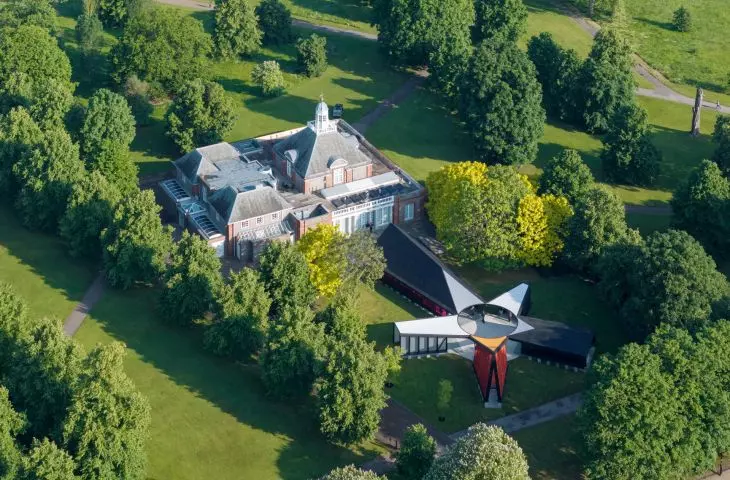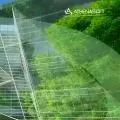sustainable small architecture
The Serpentine in London has opened a summer pavilion for the twenty-third time, which, as every year, will host seasonal events planned around it. Designed by South Korean studio Mass Studies, the pavilion is called Archipelagic Void. Architect Minsuk Cho composed influences from his native culture into spatial solutions that are friendly to any gallery audience. The pavilion will be on view until October 27, 2024.
scattered form
The eponymous archipelago is composed of islands oscillating between a space-empty referring to a madang, or traditional inner garden between Korean houses; it is a semi-private place for both social interaction and solitary reflection. By welding the five islands together with a metal circle, a total of ten spaces were created: five covered parts of the pavilion and five open spaces that connect the temporary structure to the surrounding nature. Each island, which differs from the others in size, form and name, is designed for a specific purpose as a content machine. The different parts thus serve as a library, gallery, auditorium, playground and café.
A view of the three parts of the Archipelago: The Gallery, The Library of Unread Books and The Play Tower - going from left to right
Photo: Ivan Baan |© Mass Studies, courtesy: Serpentine
the sounds of an english garden
TheGallery (The Gallery) is both the main entrance to the pavilion and the space for the six-channel sound installations: summer's The Willow Is and Moonlight, which begins in September. Architecturally, the island is minimalist: it simultaneously resembles a white cube and the walls of a Korean house made of traditional hanji paper. Drawing inspiration from the pavilion's surroundings, composer Jang Young-Gyu combined sounds of nature and human activity recorded in Kensington Gardens with traditional Korean vocal music and instruments. The tones and melodies are a response to the park's ever-changing landscape and ecology. The sound will thus carry each visitor simultaneously through the Gallery and the surrounding garden.
The pavilion at dusk
Photo credit: Ivan Baan |© Mass Studies, courtesy: Serpentine
contact with Serpentine architecture
The Play Tower is a pyramid made of wooden beams and orange netting. Rope ladders are stretched between the beams, which can be climbed. The island's simple design encourages visitors to explore the possibilities hidden in basic building materials and uncomplicated shapes.
Archipelagic Void Pavilion by Mass Studies - view of the Auditorium.
Photo: Ivan Baan |© Mass Studies, courtesy: Serpentine
The largest of the islands, The Auditorium, was designed for performances and meetings scheduled in Serpentine's summer program. Beams and columns are both structural elements and benches for the audience. Pink windows have been inserted between them, which the architect jokes about as "natural Instagram filters." The color creates a contrast between the island and the greenery of the area.
Library of Unread Books at Serpentine Galleries
Photo credit: Ivan Baan |© Mass Studies, courtesy: Serpentine
The Library of Unread Books by artist Heman Chong and archivist Renée Staal was designed as a work of art - a "living" library in the collection, with each book unread by its original owner for some reason. Visitors can contribute and pass on their reading failures. The Library of Unread Books engages the public in a collective gesture relating to notions of access and distribution. The two walls that make up the library are set at an oblique angle, but do not fully enclose the space between them. In this way, the island is semi-open to the park, which, after all, is a frequent place to indulge in reading.
The architects referenced the history of the Serpentine Galleries buildings through theTea House. Designed by James Grey West, Serpentine South opened in 1934 and originally functioned precisely as a tea house. The island houses a café where you can relax and meet with friends.
A bird's eye view of the Serpentine pavilion
Photo: Ivan Baan |© Mass Studies, courtesy: Serpentine
Construction of London's Void Archipelago
Douglas fir timber, harvested within a 30-kilometer radius of London, was used to erect the pavilion. All elements are easy to dismantle, and the leftovers can be used during the construction of another building. Such a method is not only an implementation of sustainable construction, but is also close to the philosophy of{tag:pracownie}, which sees the spaces it designs as part of a story stretched over time. Traditional Korean homes are very sparingly furnished, so according to Minsuk Cho, Koreans are making a closer, unmediated connection with the architecture itself. He urges London audiences to do the same this summer.






























